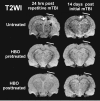Hyperbaric oxygen therapy for traumatic brain injury
- PMID: 22146562
- PMCID: PMC3231802
- DOI: 10.1186/2045-9912-1-21
Hyperbaric oxygen therapy for traumatic brain injury
Abstract
Traumatic brain injury (TBI) is a major public health issue. The complexity of TBI has precluded the use of effective therapies. Hyperbaric oxygen therapy (HBOT) has been shown to be neuroprotective in multiple neurological disorders, but its efficacy in the management of TBI remains controversial. This review focuses on HBOT applications within the context of experimental and clinical TBI. We also discuss its potential neuroprotective mechanisms. Early or delayed multiple sessions of low atmospheric pressure HBOT can reduce intracranial pressure, improve mortality, as well as promote neurobehavioral recovery. The complimentary, synergistic actions of HBOT include improved tissue oxygenation and cellular metabolism, anti-apoptotic, and anti-inflammatory mechanisms. Thus HBOT may serve as a promising neuroprotective strategy that when combined with other therapeutic targets for TBI patients which could improve long-term outcomes.
Figures


Similar articles
-
Identifying the Target Traumatic Brain Injury Population for Hyperbaric Oxygen Therapy.Int J Mol Sci. 2023 Sep 27;24(19):14612. doi: 10.3390/ijms241914612. Int J Mol Sci. 2023. PMID: 37834059 Free PMC article. Review.
-
Evidence brief: hyperbaric oxygen therapy (HBOT) for traumatic brain injury and/or post-traumatic stress disorder.Diving Hyperb Med. 2018 Jun 30;48(2):115. doi: 10.28920/dhm48.2.115. Diving Hyperb Med. 2018. PMID: 29888387 Free PMC article.
-
Hyperbaric Oxygen Therapy (HBOT) in Moderate Traumatic Brain Injury (TBI): A Randomized Controlled Trial.Asian J Neurosurg. 2024 Oct 24;20(1):69-74. doi: 10.1055/s-0044-1791997. eCollection 2025 Mar. Asian J Neurosurg. 2024. PMID: 40041595 Free PMC article.
-
Effect of hyperbaric oxygen on patients with traumatic brain injury.Acta Neurochir Suppl. 2008;101:145-9. doi: 10.1007/978-3-211-78205-7_25. Acta Neurochir Suppl. 2008. PMID: 18642650 Clinical Trial.
-
Hyperbaric oxygen therapy applied research in traumatic brain injury: from mechanisms to clinical investigation.Med Gas Res. 2014 Dec 4;4:18. doi: 10.1186/2045-9912-4-18. eCollection 2014. Med Gas Res. 2014. PMID: 25905012 Free PMC article. Review.
Cited by
-
Traumatic axonal injury (TAI): definitions, pathophysiology and imaging-a narrative review.Acta Neurochir (Wien). 2021 Jan;163(1):31-44. doi: 10.1007/s00701-020-04594-1. Epub 2020 Oct 2. Acta Neurochir (Wien). 2021. PMID: 33006648 Free PMC article. Review.
-
Quantitative evaluation of hyperbaric oxygen efficacy in experimental traumatic brain injury: an MRI study.Neurol Sci. 2014 Feb;35(2):295-302. doi: 10.1007/s10072-013-1514-6. Epub 2013 Aug 18. Neurol Sci. 2014. PMID: 23955096
-
Progress of Research on Diffuse Axonal Injury after Traumatic Brain Injury.Neural Plast. 2016;2016:9746313. doi: 10.1155/2016/9746313. Epub 2016 Dec 19. Neural Plast. 2016. PMID: 28078144 Free PMC article. Review.
-
Hyperbaric oxygen in chronic traumatic brain injury: oxygen, pressure, and gene therapy.Med Gas Res. 2015 Jul 14;5:9. doi: 10.1186/s13618-015-0030-6. eCollection 2015. Med Gas Res. 2015. PMID: 26171141 Free PMC article.
-
Hyperbaric oxygen therapy for post concussion symptoms: issues may affect the results.Med Gas Res. 2015 Aug 25;5:10. doi: 10.1186/s13618-015-0033-3. eCollection 2015. Med Gas Res. 2015. PMID: 26306183 Free PMC article.
References
-
- Zhou Z, Daugherty WP, Sun D, Levasseur JE, Altememi N, Hamm RJ. et al.Protection of Mitochondrial Function and Improvement in Cognitive Recovery in Rats Treated with Hyperbaric Oxygen Following Lateral Fluid-Percussion Injury. J Neurosurg. 2007;106:687–694. doi: 10.3171/jns.2007.106.4.687. - DOI - PubMed
-
- Tolias CM, Reinert M, Seiler R, Gilman C, Scharf A, Bullock MR. Normobaric Hyperoxia--Induced Improvement in Cerebral Metabolism and Reduction in Intracranial Pressure in Patients with Severe Head Injury: A Prospective Historical Cohort-Matched Study. J Neurosurg. 2004;101:435–444. doi: 10.3171/jns.2004.101.3.0435. - DOI - PubMed
LinkOut - more resources
Full Text Sources
Medical
Molecular Biology Databases

